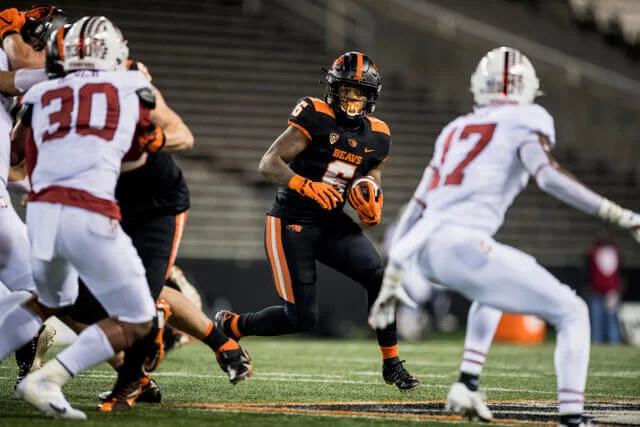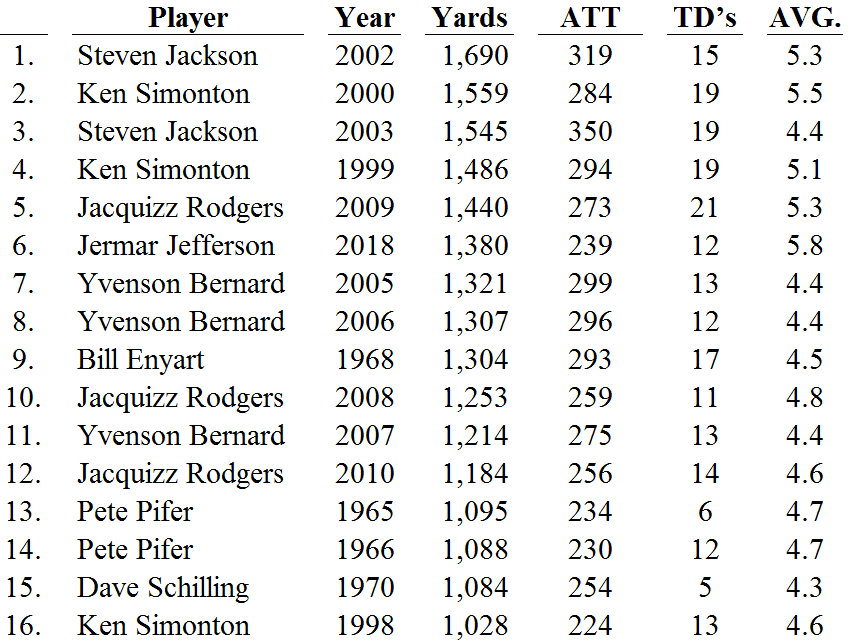‘The Whale’ spouts off on the great running backs in Oregon State history
Jim “The Whale” Wilson
Updated 4/8/2021 10:48 PM
By Jim Wilson
(Editor’s note: Oregon State’s spring practice began on April 6. To get Beaver Nation in football mode, radio analyst extraordinaire Jim “The Whale” Wilson offers his appraisal of the top five running backs in Beaver history.)
Jermar Jefferson officially ended his Oregon State career when he declared for the NFL draft in December 2020. That didn’t come as a surprise to most Beaver fans, but it does leave a huge vacancy in the Beaver backfield as Jefferson was one of the best to ever tote the football for the Orange and Black.
In three years — make that one full year and two partial seasons — Jefferson leapfrogged into the conversation as one of the top five running backs in Beaver history. He is fifth in career rushing yards behind a decorated group that includes Ken Simonton, Steven Jackson, Jacquizz Rodgers and Yvenson Bernard.
Oregon State Career Rushing Leaders
Outside of this list, there are only three other players in the history of the program to rush for over 1,000 yards in a season: Pete Pifer (twice, 1965 and ’66), Bill “Earthquake” Enyart (1968) and Dave Schilling (1970). This trio goes into a separate category; all were bruising fullbacks in Dee Andros’ “Power T” full-house backfields.
Any conversation about great Beaver running backs starts with Ken Simonton. At 5-7 and 200 pounds, Simonton had tremendous quickness, a good burst and strong legs. His trademark play was the “Power” as he worked behind pulling linemen before accelerating and finishing as well as any Beaver running back in my memory.
Simonton rewrote the Beaver record books and has been the standard-bearer for Beaver backs ever since his sterling career ended in 2001. His 5,044 yards and 59 touchdowns are both top five in Pac-12 history (fifth in rushing yards, second in touchdowns). His high-water mark came in the 2000 season when he rushed for 1,559 yards and 19 touchdowns, becoming the first Beaver to ever rush for more than 1,000 yards in three consecutive seasons.
Ken Simonton (Courtesy of Oregon State sports communications)
Adding to Simonton’s lore was the success of the 2000 OSU team. He was the catalyst for the Beavers 11-1 season that included a Pac-12 co-championship, a 41-9 romp over Notre Dame in the 2001 Fiesta Bowl and a No. 4 final AP ranking.
Jacquizz Rodgers also rushed for more than 1,000 yards in three consecutive seasons before being selected by the Atlanta Falcons in the fifth round of the 2011 NFL draft. The buzz surrounding his arrival in Corvallis was unlike any other as his older brother James dazzled fans as a freshman and promised Beaver Nation that his younger brother was even better than he was. It took all of four games for Jacquizz to announce himself on the national stage, delivering a 186-yard, two0touchdown performance to lead Oregon State to a 27-21 upset over top-ranked USC.
Rodgers was listed at 5-7, but at 190 pounds he managed to move the pile forward on most runs. He had a tremendous combination of strength and quickness and great vision to find the openings. Opponents used to complain that they couldn’t find Quizz behind the big linemen, and when he appeared it was too late.
He rushed for 1,253 yards as a freshman despite not playing the final two games of the season due to injury. Rodgers’ best year was the following campaign when he upped the rushing total to 1,440 yards and added a single-season record 21 rushing touchdowns. Maybe even more impressive was the fact that he caught 78 passes out of the backfield that season
There are only three runners in Beaver history to rush for more than 1,000 yards in three seasons — Simonton, Rodgers and Yvenson Bernard. Bernard played four seasons at Oregon State, but all but 20 of his 3,862 career yards came in his last three years. In those three seasons he averaged 1,280 yards on 290 carries.
He was a workhorse in Mike Riley’s tailback-driven offense and was best running the inside zone. Bernard had great vision, was tough and had a trademark jump cut that left many would-be tacklers empty handed.
Steven Jackson (Courtesy of Oregon State sports communications)
Steven Jackson was different from the other runners because of his size and speed. At 6-2 and 240 pounds he had the size of Enyart with breakaway speed. Jackson was a downhill, one-cut runner who punished tacklers. The Beavers often pitched him the ball on toss sweeps, forcing over-matched cornerbacks to come up and make the tackle. It wasn’t fair.
As a freshman, Jackson watched Simonton take the majority of the carries. He then went on the best two-year run in Beaver history, rushing for a single-season record 1,690 yards as a sophomore and backing that up with another 1,545 yards in 2003. He was selected by the St. Louis Rams in the first round of the 2004 draft and rushed for more than 11,000 yards in his 12-year NFL career.
That leaves Jefferson, who arrived in Corvallis in 2018 as a four-star recruit. In his second game in a Beaver uniform, he filled in for an injured Artavis Pierce and rushed for 238 yards against Southern Utah. Three games later, in Tempe, he exploded for 254 yards against Arizona State. Jefferson ended up with 1,380 yards, 12 touchdowns and a 5.7 yards-per-carry average as a freshman.
Jermar injured his foot in the second game of his sophomore season. In that game, the Beavers led Hawaii by 14 points in the second quarter and Jermar already had more than 150 rushing yards. After the injury, he missed three games, played sparingly in others, but ultimately never fully recovered. He played nine games, started six and finished the year with 685 yards.
Last year, Jermar played six of the seven Beaver games and averaged 143 yards rushing per contest. He totaled 858 yards and averaged 6.7 yards per carry, bringing his career total to 2,923 yards and fifth on the Beaver charts. His 254 yards against Arizona State and 238-yard effort versus Southern Utah are two of the top four single-game efforts in Beaver history; his 226-yard game against Oregon is the most ever in that rivalry series.
My Top Five
As in any discussion, there must be a definition of what it means to be the top player. Is it based on statistics alone or do other factors contribute? Are we talking about the best Beaver career or just one season? What about contributions in the locker room? In the community? Does an extended professional career matter?
The answer is, everything matters. It would be fair to say the career numbers of Simonton are irrefutable and the sheer dominance of Jackson is undeniable. But Rodgers’ emergence, likability, rushing resume and pass-catching numbers all add up. Bernard's warrior mentality and Jefferson’s enormous ceiling are part of the equation.
Whenever I get into discussions of this ilk, I fall back on the Baseline Test: If they all lined up on the baseline (end zone), whom would I pick for the 2021 season?
Jacquizz Rodgers (Courtesy of Oregon State sports communications)
I was very tempted to go with a 1A, 1B and 1C cop-out approach with Jackson, Simonton and Rodgers as co-winners. Those three stand above the rest, yet aren’t separated by much. The Baseline Test ultimately led me to select Jackson as my top Beaver back, placing me in yet another conundrum as Simonton and Rodgers are a virtual dead heat for the second spot. I sided with Simonton’s career numbers as the tipping point for the second spot with Jacquizz a strong third.
That left Bernard and Jefferson for the last two spots. Bernard was an absolute warrior and was extremely durable, with three consecutive seasons with more than 275 carries. Jefferson, on the other hand, fought injuries throughout his career but holds a clear edge in his open-field running capabilities. Jefferson averaged 5.7 yards per carry during his Beaver career, more than a full yard ahead of Bernard’s 4.4 career average.
Yvenson Bernard (Courtesy of Oregon State sports communications)
So the order goes this way: Steven Jackson (he wins the Baseline Test), Ken Simonton (career numbers are among the best in the history of the Pac-12), Jacquizz Rodgers (my favorite Beaver player of all time), Jermar Jefferson (his explosiveness, size and speed give him a higher ceiling) and Yvenson Bernard (his warrior mentality was contagious; he was reliable, tough and durable).
Editor’s note: Eggers’ eyeball test rates them this way: Jackson, Rodgers, Simonton, Jefferson and Bernard. The group stacks up with that of any school in the Pac-12 outside of Southern Cal, otherwise known as “Tailback U.”







